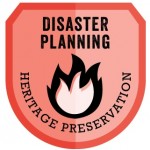 The most comprehensive disaster plans cover the four facets of the emergency management cycle—prevention, preparedness, response, and recovery—which correspond to before, during, and after a disaster. If you have been meaning to write a disaster plan but your efforts have stalled, the webinar recordings and course materials found below will help you establish the crucial first steps following a disaster. The Pocket Response Plan, or PReP™, developed by the Council of State Archivists and customizable by all institution types, was featured as a resource that will help you respond when—not if—disaster strikes.
The most comprehensive disaster plans cover the four facets of the emergency management cycle—prevention, preparedness, response, and recovery—which correspond to before, during, and after a disaster. If you have been meaning to write a disaster plan but your efforts have stalled, the webinar recordings and course materials found below will help you establish the crucial first steps following a disaster. The Pocket Response Plan, or PReP™, developed by the Council of State Archivists and customizable by all institution types, was featured as a resource that will help you respond when—not if—disaster strikes.
This course followed Risk Evaluation: First Step in Disaster Planning, which provided an overview of the disaster planning process. This course is a part of the Caring for Yesterday’s Treasures—Today series.
In addition to webinar recording links below, you will also see transcripts of those recordings, resources that were compiled by the course instructor, and PowerPoint presentations.
Webinar 1: Response: One Facet of the Emergency Management Cycle
Tuesday, March 5, 2013
2:00 – 3:30 pm EST
Instructor: Julie Page
What you do—and do not do—following a disaster can spell the difference between success and failure. Do you know who to call? Are you familiar with your facility’s emergency systems? What type of supplies do you have on hand to immediately address the situation? Which staff members have been trained to respond and to work together as a team? This overview introduced participants to the Pocket Response Plan.
Webinar 1 Complete Handouts (pdf, 2 MB)
Includes: PowerPoint presentation, generic PReP™ plan, and sample PReP™ plans
Black and white version of Webinar 1 Complete Handouts
Webinar 1 Closed Captioning Transcript
CLICK HERE FOR THE WEBINAR 1 RECORDING
For closed captions, please access this via this link.
Webinar 2: PReP™ Side A: Communications
Thursday, March 7, 2013
2:00 – 3:30 pm EST
Instructor: Julie Page
The top priority following any disaster, large or small, is human safety. Knowing how to contact or notify staff, volunteers, and patrons is key to ensuring a safe evacuation and a safe response. Who else should be on your contact list besides staff and volunteers? If the event is beyond the your institution’s capacity to address, to whom should you reach out?
Webinar 2 Complete Handouts (pdf, 4.5 MB)
Includes: PowerPoint presentation and additional handouts
Black and white version of Webinar 2 Complete Handouts
Webinar 2 Closed Captioning Transcript
CLICK HERE FOR THE WEBINAR 2 RECORDING
For closed captions, please access this via this link.
Webinar 3: PReP™ Side B: Action Steps
Tuesday, March 12, 2013
2:00 – 3:30 pm EDT
Instructor: Julie Page
When disaster strikes, confusion and chaos often replace thoughtfulness and deliberation. By having action steps outlined in advance, you don’t have to think about every detail; you can use these steps for guidance and to ensure that you are not overlooking any important activity. What are these action steps? How do you prioritize them? In many cases, it may not be possible to save all your collections. What goes into determining salvage priorities for collections?
Webinar 3 Complete Handouts (pdf, 3.3 MB)
Includes: PowerPoint presentation and additional handouts
Black and white version of Webinar 3 Complete Handouts
Guidelines for Establishing Salvage Priorities (This handout was originally missing from the packet but is now included.)
Webinar 3 Closed Captioning Transcript
CLICK HERE FOR THE WEBINAR 3 RECORDING
For closed captions, please access this via this link.
Webinar 4: Recovery
Thursday, March 14, 2013
2:00 – 3:30 pm EDT
Instructor: Julie Page
Once your collections have been stabilized, you will then have to spend many months—and perhaps even years—dealing with the consequences of the disaster, deciding what to save, what to throw out, rehabilitating the building, and treating the affected materials. This final session explored collections salvage techniques, working with a disaster recovery company, inventory control, and the importance of addressing the emotional toll that disasters can take on staff, volunteers, and other supporters of your institution.
Webinar 4 Complete Handouts (pdf, 3.4 MB)
Includes: PowerPoint presentation and additional handouts
Black and white version of Webinar 4 Complete Handouts
CLICK HERE FOR THE WEBINAR 4 RECORDING
For closed captions, please access this via this link.
Follow-up Webinar: Exercising Your Disaster Response Plan: Techniques for Testing Your Plan and Training Staff
Tuesday, June 4, 2013
2:00 – 3:30 pm EDT
Instructor: Julie Page
Even the best written disaster response plan can be greatly compromised if staff members have not been trained on how to carry it out. Conducting drills and exercises of your institution’s response plan is critical for testing procedures, identifying problems, and discussing solutions. Tabletop exercises, which are dedicated to discussion, and functional exercises, which are focused on hands-on activity, are two especially effective training approaches.
PowerPoint Presentation (Black and White)
PowerPoint Presentation (Color)
Webinar Resources Handout
Webinar Transcript
California OES Campus Disaster Preparedness Video “Academic Aftershock”
CLICK HERE FOR THE FOLLOW-UP WEBINAR RECORDING
Web Resources:
Writing a Disaster Response Plan Resource List (doc, 64 KB)
Disaster Plan Template Downloads:
PReP™ Template (doc, 63 KB)
Immediate Emergency Response (doc, 42 KB)
Facilities: Locations of Emergency Systems (doc, 38 KB)
Disaster Response/Recovery Team (doc, 38 KB)
Responsibilities During a Disaster Response & Recovery (doc, 68 KB)
Insurance Coverage (doc, 34 KB)
Field Guide Assessment Form (pdf, 94 KB)
Salvage Priorities – Collections (doc, 96 KB)
Inventory Control List (doc, 75 KB)
Disaster Response Supplies/Equipment (xls, 76 KB)
Salvage at a Glance (doc, 184 KB)
Salvage of Water Damaged Collections (doc, 144 KB)
Drying Techniques for Water Damaged Books and Paper (doc, 39 KB)
INSTRUCTOR

Julie Page is Co-Coordinator of both the California Preservation Program (CPP) and the Western States and Territories Preservation Assistance Service (WESTPAS). She presents disaster preparedness and response workshops through WESTPAS and California’s IMLS-funded Connecting to Collections project. Page has published in the areas of preservation education and disaster preparedness and established the San Diego/Imperial County Libraries Disaster Response Network. She currently serves on the Board of Heritage Preservation and their advisory committee for the Alliance for Response and is a member of the American Institute for Conservation’s Collections Emergency Response Team (AIC-CERT).




